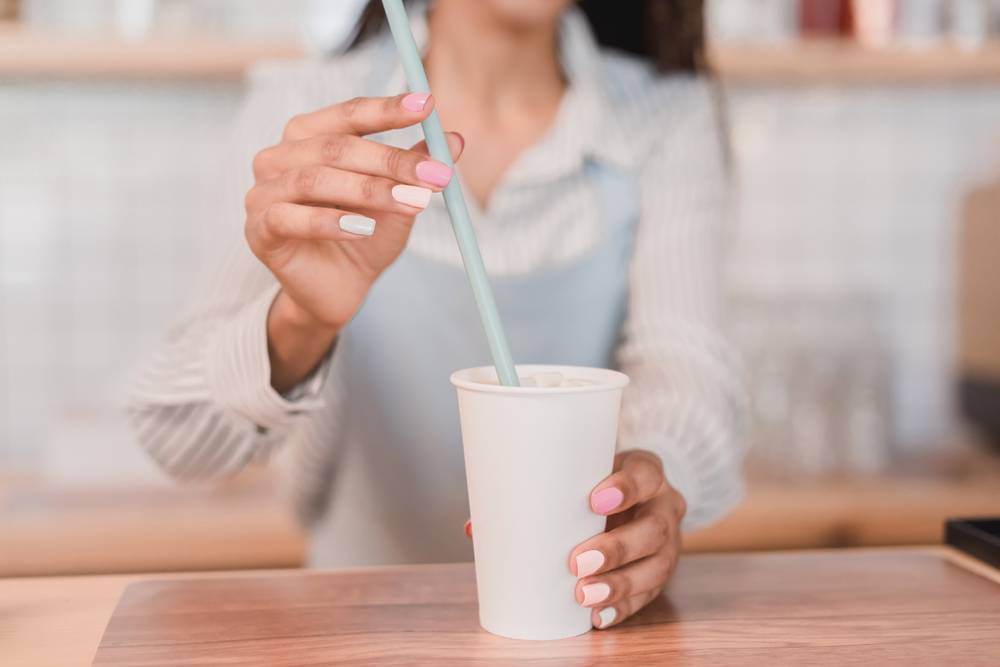When ALS Becomes a Hard Act to Swallow

Swallowing. It’s such a simple thing to do! We’re born with the ability to swallow; it happens automatically, and the average person does it approximately 600 times a day. I mean, who actually thinks about swallowing? Well, I do, now that I’ve joined the nearly 80 percent of ALS patients who have to think about how, what, and when to swallow. For us, swallowing has become a maneuver best done with absolute focus and without interruption.
A fish out of water
I didn’t experience any swallowing issues until my fourth year of ALS. The incident turned what used to be a calm drink of water following my morning stretch routine into several minutes of gagging, coughing, and gasping for air. Thinking it all was just a fluke of the moment, I brushed the episode off.
But repeat episodes throughout the week had me worried, and a timely visit to the ALS clinic confirmed that I had dysphagia.
What is dysphagia?
In ALS, dysphagia results from a weakening of the tongue and soft palate in combination with weak muscles of the throat. During the action of swallowing, a slow reaction by the throat muscles can send consumed food or drink hurtling directly toward the lungs rather than to the stomach. Coughing, pats-on-the-back, or getting to meet your local EMTs are often the results.
Depending on the severity of the symptoms, options for ALS patients can include cutting up and chewing smaller pieces of food, changing the food’s consistency by blending it or relying on a pre-mixed formula. In severe cases, surgeons implant a feeding tube (PEG) into the stomach, which can eliminate taking in food by the mouth altogether. Understandably, the decision to have a PEG inserted is an emotional one for many ALS patients.
In my case, I can still chew and swallow normal foods. But I add a powdered thickener to all my liquids.
So, how thick is thick?
Working with commercial thickeners isn’t as simple as tossing in a spoonful or two and stirring it. There’s an art, a learning curve, and as my husband and I discovered, it can transform your kitchen into a science project! The amount of powder required fluctuates widely between beverages, and even the product we use varies in strength from canister to canister.
Plus, I’ll admit that a good part of the learning curve was me having to adjust to drinking a morning cup of “thick coffee.”
Along the way, we did learn a few tips that I’m happy to pass along:
- Thickeners can be used for soups as well, but not during cooking. So, add it in when the soup is in your bowl.
- If you’ve overestimated the amount of powder needed and created a “sludge,” just add ice cubes and stir.
- Thickener in plain water can have an “off” taste. I add a few drops of flavored “drink enhancer” to the mix; it transforms the taste!
- Use caution if adding thickener to colas, beer, or other fizzing beverages — unless you are providing party entertainment! One day, I craved a cold 7UP, but when the powder hit the liquid, everything began bubbling up, over, and onto the counter. It reminded me of those viral videos of kids dropping Mentos into a bottle of Coke, resulting in an instant liquid volcano!
Click here for more helpful tips from the MND Association.
Solving drinking dilemmas when dining out
When heading out and about, I’ve found it convenient to take along my pre-mixed drink in a small sports bottle that has a built-in straw. It’s handy for car trips and at meetings because I blend right in with others who’ve brought along their own bottles of water.
Restaurants have been a bit of a challenge. Rather than put my sports bottle on the table, I hoped I could order a beverage and thicken it right there. The problem was the size of the beverage. Asking for “a small glass of …” just didn’t compute with most waitstaff. Restaurants nowadays seem only to serve drinks in oversized glasses, and when a small glass of juice finally did show up, it was packed full of ice!
The solution was a cup of coffee.
I simply order a coffee and when it arrives, stir in the powder from a repurposed pill bottle that I carry in my purse. No more explaining, frustration, or sports bottles to clean when I get home. I guess learning to like thick coffee paid off!
Living with dysphagia certainly has its challenges — it’s one of many tests that ALS throws our way. But by keeping a positive attitude and learning from each other, I believe we can live well while living with ALS.
***
Note: ALS News Today is strictly a news and information website about the disease. It does not provide medical advice, diagnosis, or treatment. This content is not intended to be a substitute for professional medical advice, diagnosis, or treatment. Always seek the advice of your physician or other qualified health provider with any questions you may have regarding a medical condition. Never disregard professional medical advice or delay in seeking it because of something you have read on this website. The opinions expressed in this column are not those of ALS News Today or its parent company, Bionews Services, and are intended to spark discussion about issues pertaining to ALS.








Chris
Not a news, just a depressing info.
The reason we come here is to find news on studies, treatments, trials, not for the obvious.
Dagmar Munn
Chris - - I'm sorry you didn't find the information in my article helpful to you. Yes, ALS News Today is a leader in offering the latest news on research, etc. However, we also offer articles sharing the patient's personal experience in living with ALS, as some readers find this helpful as well.
boyinthebarrel
I found it very helpful. Thank you, Dagmar. Keep doing what you're doing!
Dagmar Munn
Thank you!
Sophie Duguid
I just wanted to drop a line, and say this helped me a LOAD! I have just started with swallowing issues (which scares the hell out of me) and I dont want to give up my coffee! If there is a way for me to keep my coffee I blood will! thank you greatly xxxxx
Nancy Vincent
I am not a patient of ALS. My daughter-in-law is and I appreciate your articles and tips to make the patient more confortable.
Merle Lee Dunaway
I was diagnosed with ALS in Oct of 2017. I was born in Holbrook, Navajo county, Az on July 13th 1948. I have lived in Taylor, Arizona for 70 years. I am wondering if I am eligible for the $50,000 compensation. I have the Pseudobular type of Amyotrophic Lateral Scierosis so my speech, swallowing, eating, drinking, choking etc. are all affected. Please let my know what information you need from me.
Thank You for you help.
Sincerely,
Merle Lee Dunaway
[email protected]
Dagmar Munn
Merle Lee, you are going to have to enlighten us as to what compensation you are referring to. Not sure what you are asking.
Alex
well having the bulb version of ALS, I love reading and learning from patients dealing with the same problems , and offering solutions. In order to strengthen my lip tonus, I decided to learn bag piping. It's not an easy one, but its improving slowly.
Raj
Extremely helpful and practical tips. Keep up the good work.
Dagmar Munn
Thank you!
Nancy McCormick
LOVE the BLOG!!!
Dagmar Munn
Thank you!
Chalyse
I haven’t tried thickener yet, even though swallowing was an issue when I was diagnosed. For me, water is fine usually, but it seems like anything sweet turns into a syrup at the back of my throat that I can’t get down. I am basically eating soup a lot, but right away I stopped eating bread and things like pizza.
camila
please i maybe have als iam curious when the disease affect my swallowing ,will i be able to drink water?and in the last stage using the feeding tube how can i still drink liquid
Dagmar Munn
Hello Camila, The symptoms of ALS are different for each person. In the case of swallowing, some patients cannot swallow (or chew) food or thick drinks and need everything blended or thinned. Others (like me) cannot swallow thin liquids and need to have them thickened. Both adaptations of food/drink help to delay the need for a feeding tube (PEG) - - at which point blenderized food & drink is consumed via the tube. Some patients are still able to swallow small amounts of food or liquid even though they have a feeding tube. The bottom line is to discuss this with your physician.
Carmen
Hello, my mother have als and I really need to know how to help her when she got chocked while breathing and swallowing her saliva. Should I get her oxygen machine? Or what! Thank you.
Dagmar Munn
Hello Carmen, I am sorry that your mother has ALS. You should contact your doctor for an answer to your question. Your doctor will know what is best for your mother.
Rita Johnson
Dagmar, thank you for your blog & posts, I read them all the time. I currently am still working full time, so I don't always have time to input or ask questions. For me, I was diagnosed in August 2022 with Bulbar onset ALS and it's progressed to where eating orally (other than smoothies) is now not an option for me. The effort it takes is exhausting, not to mention not successful. Three weeks ago I had my PEG placement and it's now a reality that I will never taste again. As I cleaned out my refrigerator and cupboards it really became REAL.
Thank you to everyone for your stories and experiences in living with this challenge.
Blessings,
Rita
Lillian Taylor
Hi Dagmar, my daughter (24) has ALS and is having trouble swallowing gel caps with powder inside. She says they "float" in her throat and she can't get them down. Do you have an idea of how I can help her? This one supplements tastes terrible and so I don't want to stir it in liquid, I was hoping for help on her swallowing it. She still eats normally.
Dagmar Munn
Hello Lillian, I share the same difficulty in swallowing large gel caps. My solution is to chew a small amount of food and right before swallowing, pop the pill in my mouth, let it mix into the "slurry", and finally swallow. Then eat/drink another item in order to follow-up with another firm swallow. It might take some experimenting in finding the best type of food for this maneuver - - I find that vegetables ormashed potato are good. Best for me is a piece of soft cheese (like Baby Bel). The gel cap goes down easily and my throat is none the wiser!
Susie Hansen
This was very helpful. My husband had his first choking experience on water. He was very scared as was I. Is there anything I can do while he is choking to help.
Dagmar Munn
Susie, have his doctor or PT show you how to help someone who is choking. I have a signal I give to my husband that I need help and he does quick, firm smacks to my upper back.
Claire Thomas
Wow so much help here, as well as comments from others that lead me to more questions to ask doctors. My son has ALS and now has lost his speech even though he was diagnosed only 5 months ago. Already having trouble with swallowing. So all this info is extremely helpful. By commenting, does this mean I will now be on the Blog to continue learning?
Dagmar Munn
You can join the ALS News Today newsletter here(click NEWSLETTER in the upper right corner)https://alsnewstoday.com/category/living-well-with-als/
And join my ALS and Wellness Blog here: https://alsandwellness.blogspot.com/